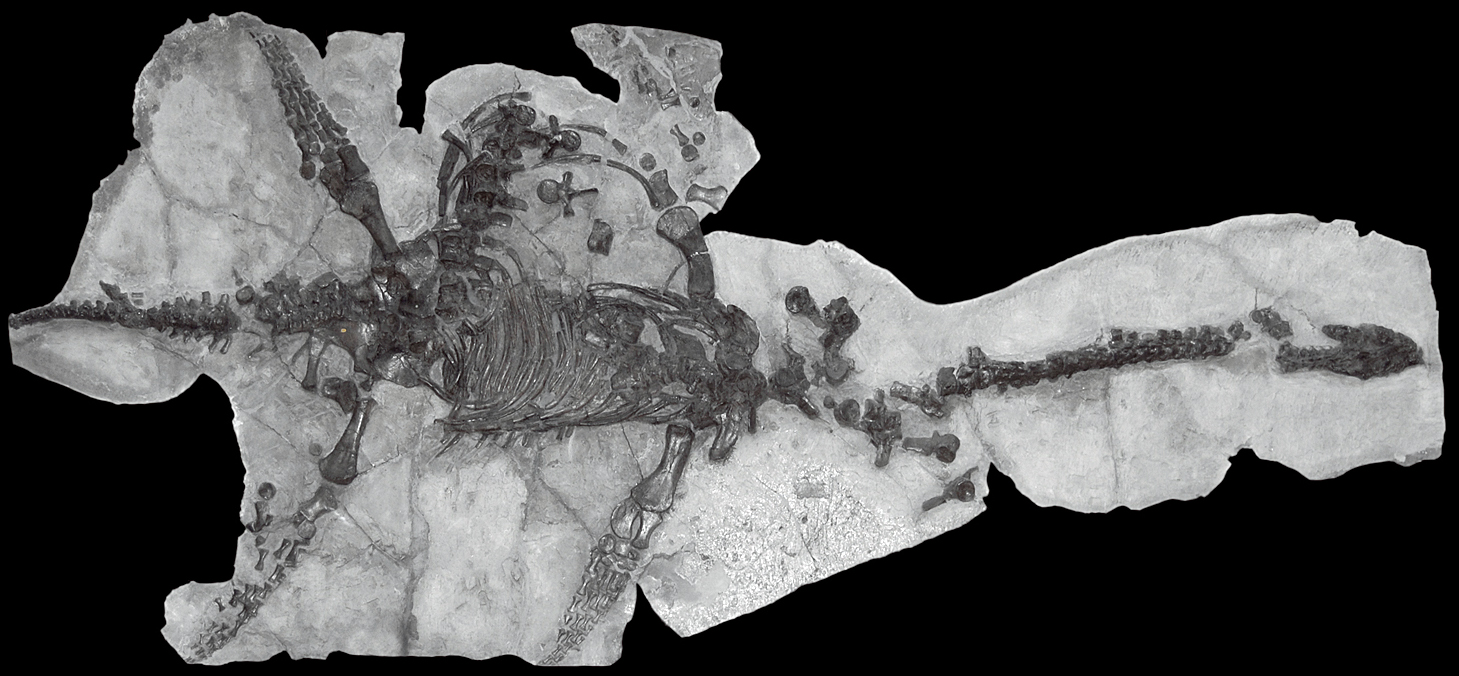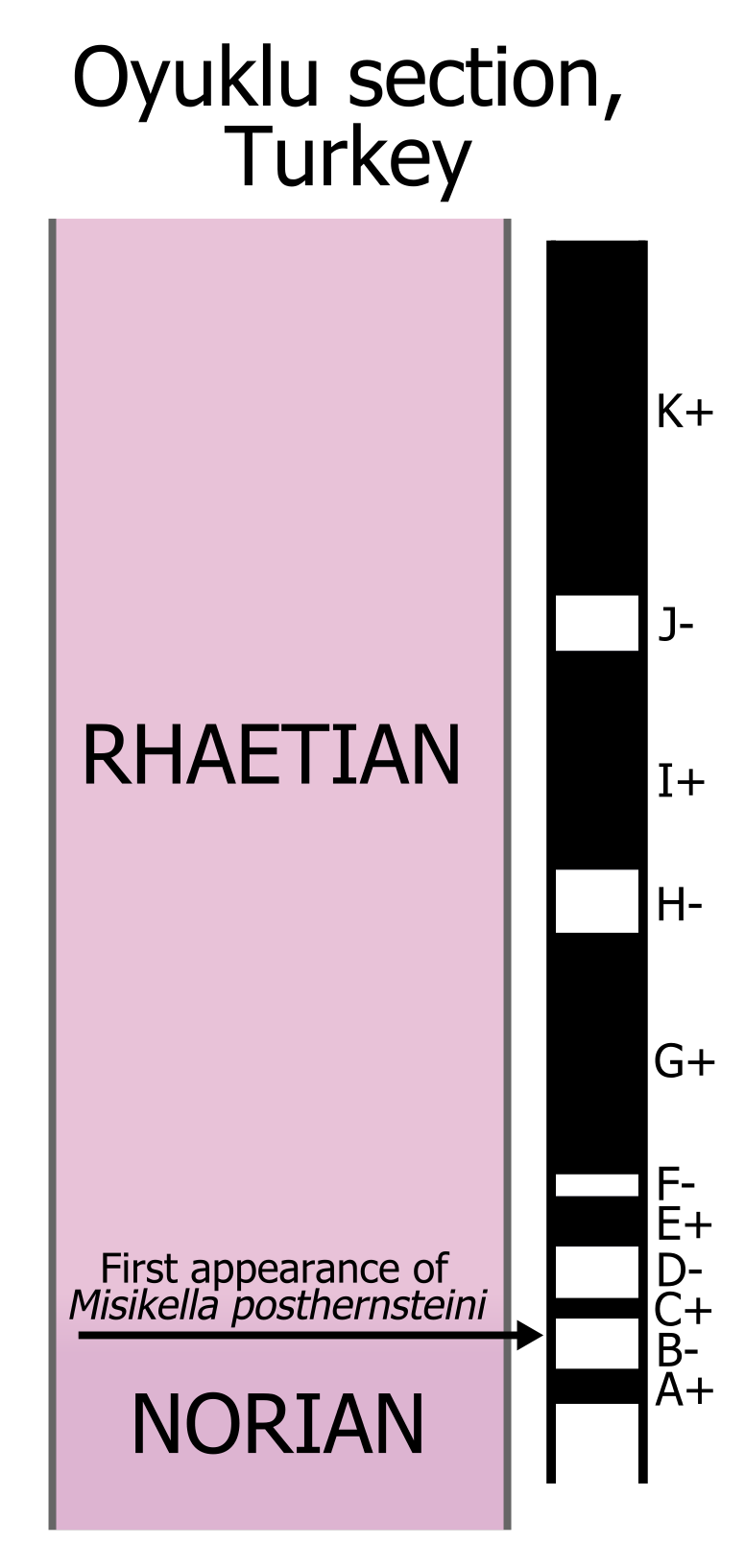|
Plesiosaurs
The Plesiosauria (; Greek: πλησίος, ''plesios'', meaning "near to" and ''sauros'', meaning "lizard") or plesiosaurs are an order or clade of extinct Mesozoic marine reptiles, belonging to the Sauropterygia. Plesiosaurs first appeared in the latest Triassic Period, possibly in the Rhaetian stage, about 203 million years ago. They became especially common during the Jurassic Period, thriving until their disappearance due to the Cretaceous–Paleogene extinction event at the end of the Cretaceous Period, about 66 million years ago. They had a worldwide oceanic distribution, and some species at least partly inhabited freshwater environments. Plesiosaurs were among the first fossil reptiles discovered. In the beginning of the nineteenth century, scientists realised how distinctive their build was and they were named as a separate order in 1835. The first plesiosaurian genus, the eponymous ''Plesiosaurus'', was named in 1821. Since then, more than a hundred valid ... [...More Info...] [...Related Items...] OR: [Wikipedia] [Google] [Baidu] |
Peloneustes
''Peloneustes'' (meaning "mud swimmer") is a genus of pliosaurid plesiosaur from the Middle Jurassic of England. Its remains are known from the Peterborough Member of the Oxford Clay Formation, which is Callovian in age. It was originally described as a species of ''Plesiosaurus'' by palaeontologist Harry Govier Seeley in 1896, before being given its own genus by naturalist Richard Lydekker in 1889. While many species have been assigned to ''Peloneustes'', ''P. philarchus'' is currently the only one still considered valid, with the others moved to different genera, considered '' nomina dubia'', or synonymised with ''P. philarchus''. Some of the material formerly assigned to ''P. evansi'' have since been reassigned to ''" Pliosaurus" andrewsi''. ''Peloneustes'' is known from many specimens, including some very complete material. With a total length of , ''Peloneustes'' is not a large pliosaurid. It had a large, triangular skull, which occupied about a fifth of its body lengt ... [...More Info...] [...Related Items...] OR: [Wikipedia] [Google] [Baidu] |
Jurassic
The Jurassic ( ) is a Geological period, geologic period and System (stratigraphy), stratigraphic system that spanned from the end of the Triassic Period million years ago (Mya) to the beginning of the Cretaceous Period, approximately Mya. The Jurassic constitutes the middle period of the Mesozoic, Mesozoic Era and is named after the Jura Mountains, where limestone strata from the period were first identified. The start of the Jurassic was marked by the major Triassic–Jurassic extinction event, associated with the eruption of the Central Atlantic magmatic province, Central Atlantic Magmatic Province. The beginning of the Toarcian Stage started around 183 million years ago and is marked by an extinction event associated with widespread Anoxic event, oceanic anoxia, ocean acidification, and elevated temperatures likely caused by the eruption of the Karoo-Ferrar, Karoo-Ferrar large igneous provinces. The end of the Jurassic, however, has no clear boundary with the Cretaceous and i ... [...More Info...] [...Related Items...] OR: [Wikipedia] [Google] [Baidu] |
Alexeyisaurus
''Alexeyisaurus'' is an extinct genus of possible plesiosaur known from the upper Triassic (lower-middle Norian age) of Wilczek Formation, Wilczek Land, of Franz Josef Land, Russia. It was first named by A. G. Sennikov and M. S. Arkhangelsky in 2010 and the type species In zoological nomenclature, a type species (''species typica'') is the species name with which the name of a genus or subgenus is considered to be permanently taxonomically associated, i.e., the species that contains the biological type specimen( ... is ''Alexeyisaurus karnoushenkoi''. While considered an elasmosaur in the initial publication It has been described as a "partial, poorly preserved, and undiagnostic sauropterygian skeleton" in subsequent publications. See also * Timeline of plesiosaur research * List of plesiosaur genera References Elasmosaurids Triassic plesiosaurs Fossil taxa described in 2010 Extinct animals of Russia Plesiosaurs of Europe Plesiosaurs of Asia Sauropterygian ... [...More Info...] [...Related Items...] OR: [Wikipedia] [Google] [Baidu] |
Plesiosauroidea
Plesiosauroidea (; Greek: 'near, close to' and 'lizard') is an extinct clade of carnivorous marine reptiles. They have the snake-like longest neck to body ratio of any reptile. Plesiosauroids are known from the Jurassic and Cretaceous periods. After their discovery, some plesiosauroids were said to have resembled "a snake threaded through the shell of a turtle", although they had no shell. Plesiosauroidea appeared at the Early Jurassic Period (late Sinemurian stage) and thrived until the K-Pg extinction, at the end of the Cretaceous Period. The oldest confirmed plesiosauroid is ''Plesiosaurus'' itself, as all younger taxa were recently found to be pliosauroids. While they were Mesozoic diapsid reptiles that lived at the same time as dinosaurs, they did not belong to the latter. Gastroliths are frequently found associated with plesiosaurs. History of discovery The first complete plesiosauroid skeletons were found in England by Mary Anning, in the early 19th century, a ... [...More Info...] [...Related Items...] OR: [Wikipedia] [Google] [Baidu] |
Anningasaura
''Anningasaura'' is an extinct genus of basal plesiosaur. It is known from a single type species, ''A. lymense'', discovered in Early Jurassic rocks of Lyme Regis in the United Kingdom. Discovery ''Anningasaura'' is known only from the holotype specimen NHMUK 49202, which consists of a complete skull, palate, and mandible, with eight associated cervical vertebrae, including the atlas-axis complex. The partial skeleton came from a juvenile plesiosaur. It was originally referred to ''"Plesiosaurus" macrocephalus'' by Charles William Andrews in 1896, which is otherwise known only from the very young type specimen NHMUK OR1336. NHMUK 49202 was collected at Lyme Regis, of Dorset, from the Hettangian to early Sinemurian-aged beds of the Lower Lias Group. Description NHMUK 49202 possesses plesiomorphic characters, including premaxillae that do not separate the frontals on the midline, narrow cranioquadrate passages and the lack of a constricting groove around t ... [...More Info...] [...Related Items...] OR: [Wikipedia] [Google] [Baidu] |
Plesiosaurus
''Plesiosaurus'' (Greek: ' ('), near to + ' ('), lizard) is a genus of extinct, large marine sauropterygian reptile that lived during the Early Jurassic. It is known by nearly complete skeletons from the Lias of England. It is distinguishable by its small head, long and slender neck, broad turtle-like body, a short tail, and two pairs of large, elongated paddles. It lends its name to the order Plesiosauria, of which it is an early, but fairly typical member. It contains only one species, the type, ''Plesiosaurus dolichodeirus''. Other species once assigned to this genus, including ''P. brachypterygius'', ''P. guilielmiimperatoris'', and ''P. tournemirensis'' have been reassigned to new genera, such as ''Hydrorion'', ''Seeleyosaurus'' and ''Occitanosaurus''. Discovery The first complete skeleton of ''Plesiosaurus'' was discovered by early paleontologist and fossil hunter Mary Anning in Sinemurian (Early Jurassic)-age rocks of the lower Lias Group in December 1823.Storrs 1997 pp ... [...More Info...] [...Related Items...] OR: [Wikipedia] [Google] [Baidu] |
Pliosauroidea
Pliosauroidea is an extinct clade of plesiosaurs, known from the earliest Jurassic to early Late Cretaceous. They are best known for the subclade Thalassophonea, which contained crocodile-like short-necked forms with large heads and massive toothed jaws, commonly known as pliosaurs. More primitive non-thalassophonean pliosauroids resembled pleisiosaurs in possessing relatively long necks and smaller heads. They originally included only members of the family Pliosauridae, of the order Plesiosauria, but several other genera and families are now also included, the number and details of which vary according to the classification used. The distinguishing characteristics are a short neck and an elongated head, with larger hind flippers compared to the fore flippers, the opposite of the plesiosaurs. They were carnivorous and their long and powerful jaws carried many sharp, conical teeth. Pliosaurs range from 4 to 15 metres and more in length. Their prey may have included fish, sharks, ... [...More Info...] [...Related Items...] OR: [Wikipedia] [Google] [Baidu] |
Edward Lhuyd
Edward Lhuyd FRS (; occasionally written Llwyd in line with modern Welsh orthography, 1660 – 30 June 1709) was a Welsh naturalist, botanist, linguist, geographer and antiquary. He is also named in a Latinate form as Eduardus Luidius. Life Lhuyd was born in 1660, in Loppington, Shropshire, England, the illegitimate son of Edward Lloyd of Llanforda, Oswestry, and Bridget Pryse of Llansantffraid, Ceredigion, Llansantffraid, near Tal-y-bont, Ceredigion, Talybont, Cardiganshire in 1660. His family belonged to the gentry of south-west Wales. Though well-established, the family was not wealthy. His father experimented with agriculture and industry in a manner that impinged on the new science of the day. The son attended and later taught at Oswestry School, Oswestry Grammar School and went up to Jesus College, Oxford in 1682, but dropped out before graduation. In 1684, he was appointed to assist Robert Plot, Curator, Keeper of the Ashmolean Museum (then in Broad Street, Oxford, B ... [...More Info...] [...Related Items...] OR: [Wikipedia] [Google] [Baidu] |
Great Britain
Great Britain is an island in the North Atlantic Ocean off the northwest coast of continental Europe. With an area of , it is the largest of the British Isles, the largest European island and the ninth-largest island in the world. It is dominated by a maritime climate with narrow temperature differences between seasons. The 60% smaller island of Ireland is to the west—these islands, along with over 1,000 smaller surrounding islands and named substantial rocks, form the British Isles archipelago. Connected to mainland Europe until 9,000 years ago by a landbridge now known as Doggerland, Great Britain has been inhabited by modern humans for around 30,000 years. In 2011, it had a population of about , making it the world's third-most-populous island after Java in Indonesia and Honshu in Japan. The term "Great Britain" is often used to refer to England, Scotland and Wales, including their component adjoining islands. Great Britain and Northern Ireland now const ... [...More Info...] [...Related Items...] OR: [Wikipedia] [Google] [Baidu] |
Antwerp
Antwerp (; nl, Antwerpen ; french: Anvers ; es, Amberes) is the largest city in Belgium by area at and the capital of Antwerp Province in the Flemish Region. With a population of 520,504,Statistics Belgium; ''Loop van de bevolking per gemeente'' (Excel file) Population of all municipalities in Belgium, . Retrieved 1 November 2017. it is the most populous municipality in Belgium, and with a metropolitan population of around 1,200,000 people, it is the second-largest ... [...More Info...] [...Related Items...] OR: [Wikipedia] [Google] [Baidu] |
Rhaetian
The Rhaetian is the latest age of the Triassic Period (in geochronology) or the uppermost stage of the Triassic System (in chronostratigraphy). It was preceded by the Norian and succeeded by the Hettangian (the lowermost stage or earliest age of the Jurassic). The base of the Rhaetian lacks a formal GSSP, though candidate sections include Steinbergkogel in Austria (since 2007) and Pignola-Abriola in Italy (since 2016). The end of the Rhaetian (and the base of the overlying Hettangian Stage) is more well-defined. According to the current ICS (International Commission on Stratigraphy) system, the Rhaetian ended ± 0.2 Ma ( million years ago). In 2010, the base of the Rhaetian (i.e. the Norian-Rhaetian boundary) was voted to be defined based on the first appearance of '' Misikella posthernsteini'', a marine conodont. However, there is still much debate over the age of this boundary, as well as the evolution of ''M. posthernsteini''. The most comprehensive source of precise ... [...More Info...] [...Related Items...] OR: [Wikipedia] [Google] [Baidu] |
Richard Verstegen
Richard Rowlands, born Richard Verstegan (c. 1550 – 1640), was an Anglo-Dutch antiquary, publisher, humorist and translator. Verstegan was born in East London the son of a cooper; his grandfather, Theodore Roland Verstegen, was a refugee from Guelders who arrived in England around the year 1500. A convert to the Catholic Church, Rowlands produced an English translation of the Little Office of the Blessed Virgin Mary; the translation and primer prayer book that contained it remained among the most popular English Catholic devotionals for two centuries. Biography Under the patronym Rowlaunde, Richard went to Christ Church, Oxford, in 1564, where he may have studied early English history and the Anglo-Saxon language. Having become a Catholic, he left the university without a degree to avoid swearing the Oath of Supremacy. Thereafter he was indentured to a goldsmith, and in 1574 became a freeman of the Worshipful Company of Goldsmiths. In 1576 he published a guidebook to West ... [...More Info...] [...Related Items...] OR: [Wikipedia] [Google] [Baidu] |








